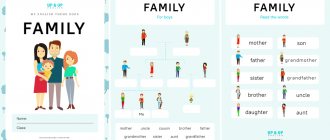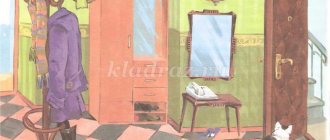Notes of OOD in English (20 notes) lesson plan (senior group)
Lesson outline on the topic: “Colors”. (senior group) (Stereotyping-situational stage - formation of automation).
Goal: development of lexical and grammatical skills using a fairy tale on the theme “Colors”.
Tasks:
1. Teach children new lexical units on the topic “Colors”: purple, golden, beige, turquoise.
2. Continue to teach children to act according to the model.
3. Continue teaching children to use speech patterns: “It is…”, “I like…” “What is it?”.
Language material for active use in speech:
-names of colors (green, yellow, red, blue, pink, brown, orange, grey, white, black, purple, golden, beige, turquoise).
Language material for recognition:
-commands (Let's see it, Let's repeat, Please, take your chairs and go out!)
Expected results:
1. Children will be able to act according to the model.
2. Children will learn to use speech patterns “It is…”, “I like…” “What is it?” using LE on the topic: “Colors”.
3. The children mastered the proposed language material.
1. Organizational moment. (3 min)
T: “Hello, my dear children! I am glad to see you! How are you?”
CH: “I am fine”
T: “Very well! I am fine too!”
T: “Guys, let’s start our lesson by repeating our greeting poem! Turn to each other and say good morning!” (Poem)
SN: Good morning, good morning,
Good morning to you,
Good morning, good morning,
I'm glad to see you.
T: “Good for you! Well done!”
2. Main part. (21 min)
T: “Children, they are many colors in English. Let's see it! (On the board there are cards of the colors that the children already know (Green, red, blue, yellow, brown, white, black, orange, grey, pink)). Please name these colors. For example, it is green. What is it?” (Children take turns calling the colors, then ask each other). (2 min)
T: “That`s right! And now I will tell you a fairy tale about the octopus Gosha. I'm sure you'll like it! Only some of the words in it are written in English, so when you hear them, say them out loud in Russian! All right? Agreed?
SN: “Yes”
T: “In the huge deep ocean lives the octopus Gosha. He likes everything colorful, beautiful, bright. That's why he loves to look at small fish that move in moving schools here and there... They are very bright, colorful and cheerful!
And for many days the octopus dreams that someday he will learn to draw, and that he will always be surrounded by colorful paintings. And so, Gosha began to look for paints, because there is so much on the bottom of the ocean! But he always came across something wrong - shipwrecks, chests, even skeletons...
Finally, he found jars of paints among other things, lined them up in front of him and began to examine them. “Oh, what wonderful, magnificent colors!” - Gosha said.
“Here is green, it’s like algae; This is yellow, it’s like sand.”
Seeing a jar of red paint, Gosha thought about it. What does red look like? Oh yes! “red is like coral, and blue is like the sky!” Even an octopus living in the depths of the ocean knows what color the sky is, because it also sometimes looks up...
At that moment, a school of fish swam by. They were so beautiful and colorful! And pink, and brown, and orange, and grey! And everyone was scurrying up and down!
And Gosha, too, admiring them, looked up and down! And so, when he looked up again, the octopus saw the white sail of a yacht through the water. It was beautiful too. He liked white as well as other colors.
Gosha, returning to his jars and remembering what colors he had seen during the day, began to test his memory. Looking at his “treasures,” he said: “green looks like grass and algae; - yellow looks like sand and the sun; -red, same as corals; - blue, the same as the sky! And these colors - pink, brown, orange, gray - are like the scales of cheerful little fish that swam up and down.
And Gosha had two more colors in jars. One of them is white, like the sail of the yacht he saw that day. And the other color is black. Gaucher didn't really like this color.
He reminded him of the not best days of his childhood, when his mother scolded little Gosha because his neck was dirty and black. “And how did I manage to get my neck dirty, being in the water all the time?” - the matured Gosha sometimes thought.
Now he understood his mother. I also understood that a dirty and black neck is ugly. But, the octopus thought, if you paint everything black, and then draw patterns or fish on top in different, bright colors, it will be beautiful...
Gosha is very tired. He went to bed and fell asleep happy. Because tomorrow he will DRAW!” (8 min)
T: “Guys, did you like the fairy tale?”
SN: “Yes!”
T: “That's great! Wonderful! But you and I don’t know the names of all flowers, would you like to know a few more? Then look at our magical flower! Look at the magic flower! What colors are its petals?
CH: “purple, golden, beige, turquoise.”
T: “That`s right! Purple will be purple in English. Repeat, please! For example, a purple ball. Golden will be golden. Repeat, please all together! For example, a golden ball. Beige will be beige, a beige ball. And turquoise is turquoise, a turquoise ball. Let's repeat!" (together and individually). (5 min)
T: “Good for you, my dears!” Well, have you stayed too long? Stand up, my children!” (Physical education minute)
When I see red I put my hands on my head.When I see blue I touch my shoe. When I see green I wash my face real clean. When I see yellow I wave to the fellows. When orange is found I put my hands on the ground. When I see pink I think, I think, I think. (2 times)
T: “Very well! Sit down, please!” (2 min)
T: “Now let’s mix our paints (pictures with colors are mixed and turned face down) and play “Yes or no,” okay?” (Children take turns taking out one card with a color, look at the color, but do not show it to anyone, and others must guess this color using the questions “Is it...?”. The one who guesses takes the place of the leader).
T: “Kira, is it red?”
SN: “No, it isn`t” (Further according to the sample).
T: “That's perfectly correct. Absolutely right." (4 min)
3. Final part. (2 min)
T: “Guys, what new colors did we learn today? What did you like most about today's lesson?
SN: “I found out that purple is purple in English”
T: “Well done! Our lesson is over! Thanks for good job! Please, take your chairs and go out!”
At what age should you start studying?
The examples of Mowgli children available in history convincingly illustrate that you can teach a person to talk only in childhood; later this is no longer possible. In the case of learning a foreign language, the situation is similar: the earlier a child starts learning it, the better it is learned - that’s what scientists say. On the other hand, many parents and teachers are confident that there is no point in spending time and money on teaching English to preschoolers, since at middle or high school age children are able to master the material in 1-3 months to the extent that children spend a whole year on .
An analysis of the characteristics of foreign language acquisition by children and adults in the context of the following categories will help weigh the pros and cons.
- Phonetics and pronunciation. Thanks to the excellent ability to imitate, which remains in children after they have completely mastered the phonetic system of their native language, preschoolers can easily imitate unusual foreign sounds. An adult, unless he has extraordinary abilities, will not be able to reproduce many sounds correctly if the phonetic base was not laid in childhood.
- Grammar. This section of a foreign language is mastered through targeted study, and therefore is accessible only to children of middle school age and older. Preschoolers can only mechanically memorize and repeat individual phrases.
- Reading. The ability to read even short texts in a foreign language implies at least basic knowledge of the rules of grammar. Kids can only read individual words or memorized songs and poems.
- Lexicon. Here the advantage is also in favor of the older age, since the number of new words increases as various topics are studied, and for preschoolers their number is limited.
It turns out that the main advantage of English language courses for preschool children is creating the basis for good pronunciation. If a child attends classes 2 times a week, at best he will get a rough introduction to the subject and master the sound system. Another thing is the parallel study of two languages, as happens in bilingual families. In this case, both languages are involuntarily acquired by the child as native languages at a conversational level, and reading and writing develop later.
Fly High Kids Academy: every child is unique!
Future citizens of the world must comprehend not only the authentic features of cultures, but also their similarities and become accustomed to the awareness of their unity. It is precisely life in the international world and free communication with representatives of different nations that is taught at the Children's Academy of Aerobatics.
The kindergarten accepts children from the age of one and a half years, but classes in bilingual groups begin only at 3.5. Groups are formed on an international basis: children from different countries learn to interact while playing and resolving everyday situations. The process is led by native speaking teachers. There is a daily routine, organized classes too, but the children are allowed to fool around and try themselves in all areas of activity.
Minuses
But, of course, there is a downside. Critics argue that bilingual education in kindergarten can place undue stress on children.
In a regular kindergarten, between the ages of three and five, many children do not yet speak their native language properly. And if you add learning a second language at the same time, it can confuse and disorient a young student.
Therefore, a child must first master his native language, and only then does it make sense to add another language to his learning.
Opponents of teaching English in kindergarten also believe that there are more important aspects that need to be taught to children first. For example, it is more important to train children's senses and emotional skills, as well as develop motor activity.
Bilingual kindergartens and schools are an investment in the child’s future
Bilingual education has many advantages over conventional education. Children master a foreign language as a second native language, broaden their horizons, and become familiar with the main components of Anglo-American culture. They have a high degree of adaptability to change, become tolerant and more easily integrate into a new society.
There are several bilingual preschool institutions in Moscow. The most famous of them:
- Heritage School is an international primary school and kindergarten, teaching according to the British Early Years Foundation Stage (EYFS) program and the Russian state school curriculum (and Mr Great and I cannot be happier that we chose this particular school for our children!);
- P'titCREF is a trilingual kindergarten that unites children who speak English, French and Russian.
- Baby-Bilingual Club - a club for early language development, provides complete immersion in the language environment;
- English Nursery & Primary School is a kindergarten and primary school that combines the best traditions of British and Russian education; education is conducted by immersion in an English-speaking environment.
To make sure you don’t make a mistake in your choice, I recommend using my husband’s proprietary checklist! This is what we were guided by when making our choice.
Mr Great checklist for choosing a bilingual kindergarten
- Find out what methodology the kindergarten uses (content-based or subject-based). I repeat, content is more effective;
- Ask about the teaching staff. It is important that most teachers are native speakers of a foreign language;
- Make sure that subject teachers do not change every month; a stable teaching staff is important, so you won’t have to worry that in the middle of the school year a native speaker teacher will not be replaced by a Russian-speaking colleague;
- Study the extracurricular life of the school, not only classes are important, but also the general atmosphere, cultural integration in an interlingual environment;
- Find out under what conditions the school building is used, this is important; it will be extremely inconvenient if, at the height of the school year, the school fails to renew the lease agreement, and the kindergarten will have to move to the other end of the city.
And most importantly, dear parents: when choosing a bilingual preschool for your child, take the trouble to attend a trial lesson. This will allow you to assess how suitable this kindergarten is for your child and meets its goals and objectives. Personal impressions are the most important!
Always yours, Mrs Britain
Key benefits of bilingual practice
To summarize, I will try to highlight for you the most important advantages that bilingual education has. So:
- communication skills develop;
- memory and logic are stimulated;
- vocabulary and conceptual stock expands.
A bilingual child studies the history and culture of both countries. He develops fluent spoken language and correct pronunciation, and instantly switches easily from one language to another. Bilingual children are special; as they get older, they have the ability to quickly change activities, concentrate better and can solve two problems at the same time. It’s a pleasure to watch such kids, I tell you!
What is a bilingual kindergarten
Agree that fluency in English is a mandatory requirement for successful professional development in many areas. How would you like your heir to study or train abroad? Got a well-paid position in an international corporation or a large domestic company? To achieve such results, young ladies and gentlemen need to be fluent in a foreign language.
Scientists (and not only British ones, ha-ha) have proven that a person is able to master English at the native level only if he studies the language from childhood with native speakers. The English-speaking environment is the main secret! To lay a good foundation for language acquisition, it is worth sending your child to a bilingual kindergarten.





